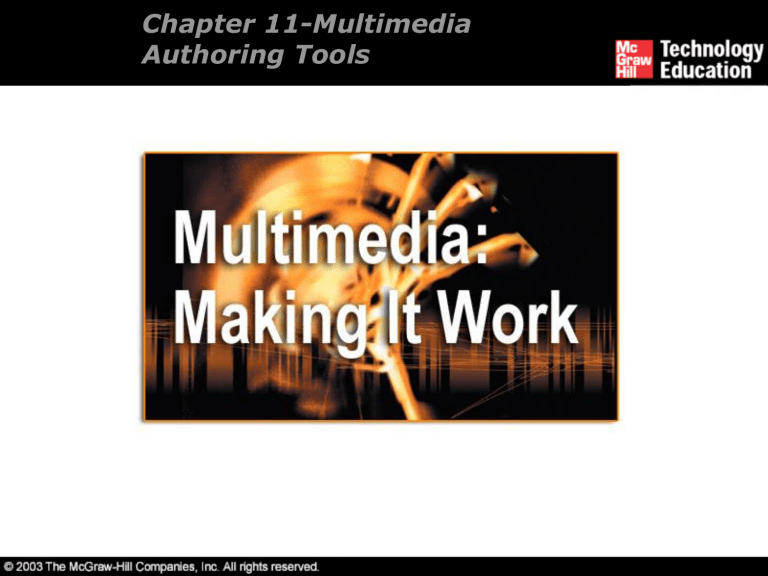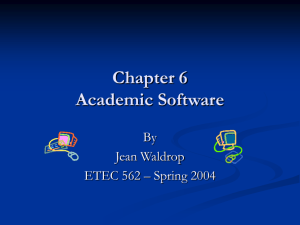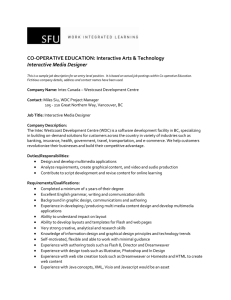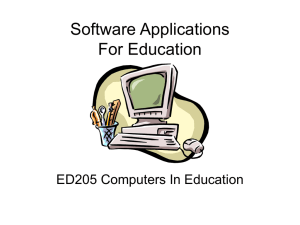Chapter 11-Multimedia Authoring Tools

Chapter 11-Multimedia
Authoring Tools
Overview
Introduction to multimedia authoring tools.
Types of authoring tools.
Cross-platform authoring notes.
Introduction to Multimedia
Authoring Tools
Multimedia authoring tools provide the framework for organizing and editing the elements of a multimedia project.
Authoring software provides an integrated environment for combining the content and functions of a project.
It enables the developer to create, edit, and import data.
Introduction to Multimedia
Authoring Tools
Authoring system in multimedia.
Features of authoring tools.
Authoring System in
Multimedia
In multimedia authoring systems, multimedia elements and events are often regarded as objects.
Objects exist in a hierarchical order of parent and child relationships.
Each object is assigned properties and modifiers.
On receiving messages, objects perform tasks depending on the properties and modifiers.
Features of Authoring Tools
Editing and organizing features.
Programming features.
Interactivity features.
Performance tuning and playback features.
Delivery, cross-platform, and Internet playability features.
Editing and Organizing
Features
Authoring systems include editing tools to create, edit, and convert multimedia elements such as animation and video clips.
The organization, design, and production process for multimedia involves storyboarding and flowcharting.
Visual flowcharting or overview facility illustrates project structure at a macro level.
Programming Features
Visual programming with icons or objects is the simplest and easiest authoring process.
Visual authoring tools such as Authorware and IconAuthor are suitable for slide shows and presentations.
Authoring tools offer ‘very high level language’ (VHLL) or interpreted scripting environment.
Interactivity Features
Interactivity gives the end user control over the content and flow of information in a project.
Simple branching is the ability to go to another section of the multimedia production.
Interactivity Features
Conditional branching is an activity based on the results of
IF-THEN decisions or events.
Structured language supports complex programming logic, subroutines, event tracking, and message passing among objects and elements.
Performance Tuning and
Playback Features
Achieving synchronization is difficult, considering that performance of the different computers used for multimedia development and delivery varies.
Authoring system should facilitate precise timing of events.
It should enable developers to build a part of a project and then test it immediately.
Delivery, Cross-Platform, and
Internet Playability Features
Delivering the project may require building a run-time version of the project, using the multimedia authoring software.
Run-time version or standalone allows a project to play back without the complete authoring software and all its tools and editors.
Delivery, Cross-Platform, and
Internet Playability Features
It is important to use tools that facilitate easy transfer across platforms.
Authoring systems provide a means for converting their output to be delivered within the context of HTML or
DHTML.
Types of Authoring Tools
Card- and page-based tools.
Icon-based, event-driven tools.
Time-based tools.
Card- and Page-Based Tools
Card- and page-based authoring systems provide a simple and easily understood metaphor for organizing multimedia elements.
It contains media objects such as buttons, text fields, and graphic objects.
It provides a facility for linking objects to pages or cards.
Icon-Based, Event-Driven
Tools
Icon-based, event-driven tools provide a visual programming approach to organize and present multimedia.
Multimedia elements and interaction cues are organized as objects in a flowchart.
Flowchart can be built by dragging appropriate icons from a library, and then adding the content.
Time-Based Tools
Time-based tools are best suited for messages with a beginning and an end.
Some time-based tools facilitate navigation and interactive control.
Macromedia’s Director and Flash are time-based development environments.
Time-Based Tools
Macromedia Director:
A multimedia database, ‘Cast’, contains still images, sound files, text, shapes, scripts, movies, and other Director files.
Score is a sequencer for displaying, animating, and playing
Cast members.
Lingo is an object-oriented scripting language that enables interactivity and programmed control.
Time-Based Tools
Macromedia Flash:
Flash is used for delivering rich multimedia content to the
Web.
It allows the creation of simple static HTML pages with the
Flash Player plug-in.
Cross-Platform Authoring
Notes
Macintosh and Windows computers use different schemes to manage text and colors.
While using text fields, ensure that the text displays correctly on both platforms.
Outline and shadow styles on text should be avoided on
Macintosh since they are not currently supported in
Windows.
Summary
Multimedia authoring tools provide the framework needed for organizing and editing multimedia elements in a project.
The three types of authoring tools are card- or page-based, icon-based or event-driven, and time-based.
Text and color compatibility must be verified before moving multimedia projects across platforms.



